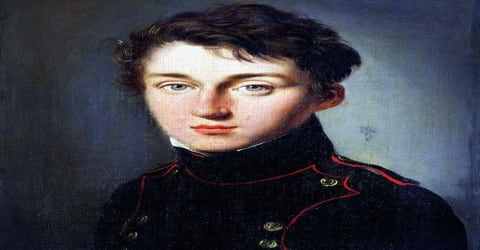Biography of Al Jolson
Al Jolson – Jewish-American singer, comedian, professional wrestler, and actor.
Name: Asa Yoelson
Date of Birth: May 26, 1886
Place of Birth: Seredžius, Kovno Governorate, Russian Empire
Date of Death: October 23, 1950 (aged 64)
Place of Death: The Westin St. Francis San Francisco on Union Square, San Francisco, California, United States
Occupation: Actor, Comedian, Singer
Father: Moses Rubin Yoelson
Mother: Naomi Yoelson
Spouse/Ex: Henrietta Keller9 (m. 1907 – div. 1920), Alma Osbourne (m. 1922 – div. 1928), Ruby Keeler (m. 1928 – div. 1940), Erle Galbraith (m. 1945 – his death. 1950)
Children: Albert Peter Lowe, Alicia Jolson, Asa Jolson Jr.
Early Life
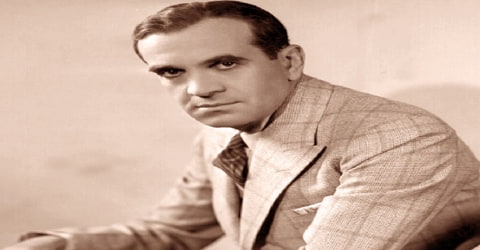
Al Jolson, a popular American singer and blackface comedian of the musical stage and motion pictures, was born on May 26, 1886, in the Jewish village of Srednike (Yiddish: סרעדניק) now known as Seredžius, near Kaunas in Lithuania, then part of the Russian Empire. At the peak of his career, he was dubbed “The World’s Greatest Entertainer”. His performing style was brash and extroverted, and he popularized many songs that benefited from his “shamelessly sentimental, melodramatic approach.” In the 1920s, Jolson was America’s most famous and highest-paid entertainer.
Jolson appeared in many musicals in New York that were immensely popular at that time. He starred in ‘The Jazz Singer,’ which was the first feature film to synchronize speech and music. He soon had several films to his credit. Jolson became an important figure in the sound-motion picture era courtesy to his brash, melodramatic, and extravagant performing style. Apart from films, he was also a star on Broadway and hosted several radio shows as well. His popularity was such that many of his Broadway show sold out very quickly. He remained one of the highest paid performers in movies during the dawn of Hollywood. His career briefly fizzled out during his 40s, but he soon made a comeback. He toured overseas to entertain the American military during World War II, and his performances were highly praised. His musical comedies and vaudeville sketches remained immensely popular even after his death.
According to music historian Larry Stempel, “No one had heard anything quite like it before on Broadway.” Author Stephen Banfield wrote that Jolson’s style was “arguably the single most important factor in defining the modern musical”.
His unique singing style and personal magnetism established an immediate rapport with audiences. Jolson has been dubbed “the king of blackface” performers, a theatrical convention since the mid-19th century. With his dynamic style of singing jazz and blues, he became widely successful by extracting traditionally African-American music and popularizing it for white American audiences who were otherwise not receptive to the originators. Despite his promotion and perpetuation of black stereotypes, his work was sometimes well-regarded by black publications and he has sometimes been credited for fighting against black discrimination on Broadway as early as 1911. In an essay written in the 21st century, Ted Gioia of the Jim Crow Museum of Racist Memorabilia remarked, “If blackface has its shameful poster boy, it is Al Jolson”, showcasing Jolson’s complex legacy in American society.
Childhood, Family and Educational Life
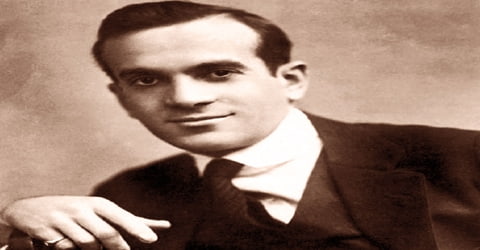
Al Jolson, by name of Asa Yoelson (Yiddish: אַסאַ יואלסאָן), was born on 26 May 1886, in Srednike, Lithuania, which was a part of Russia at that time. He was the youngest child of Moses Yoelson and Naomi Cantor. He had four siblings. His family was Jewish, and his father was a rabbi and cantor. Jolson did not know his date of birth, as birth records were not kept at that time in that region, and he gave his birth year as 1885.
Jolson’s family came to the United States in 1894, settling in Washington, D.C. Several factors in Jolson’s youth influenced his career, including his religious Jewish upbringing, the death of his mother when he was ten, and his father’s work as a cantor (a singer of religious music in a synagogue). Jolson acquired a love of singing from his father, but he did not want to use his voice in the synagogue. Instead, he and his brother Harry sang on street corners to earn money. Jolson also attended the theater whenever possible and discovered he loved to perform.
Jolson spent time at the St. Mary’s Industrial School for Boys, a progressive reformatory/home for orphans run by the Xaverian Brothers in Baltimore (the same school which would later be attended by Babe Ruth). After being introduced to show business in 1895 by Al Reeves, Jolson and Hirsch became fascinated by it, and by 1897 the brothers were singing for coins on local street corners, using the names “Al” and “Harry”. They often used the money to buy tickets to the National Theater. They spent most of their days working different jobs as a team.
Personal Life
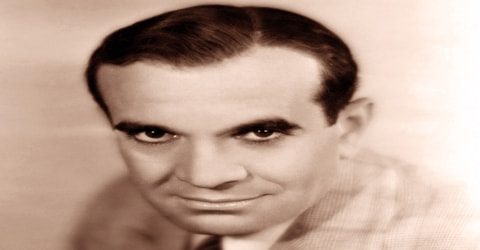
Al Jolson’s first marriage to Henrietta Keller (1889-1967) took place in Alameda California, on September 20, 1907. His name was given as Albert Jolson. They divorced in 1919. In 1920, he began a relationship with Broadway actress Alma Osbourne (known professionally as Ethel Delmar); the two were married in August 1922; she divorced Jolson in 1928.
Jolson started dating Ruby Keeler, a tap dancer, in the summer of 1928. They soon married in September and adopted a son, Al Jolson Jr. They divorced in 1939.
In 1944, while giving a show at a military hospital in Hot Springs, Arkansas, Jolson met a young X-ray technologist, Erle Galbraith. He became fascinated with her and more than a year later he was able to track her down and hired her as an actress while he served as a producer at Columbia Pictures. After Jolson, whose health was still scarred from his previous battle with malaria, was hospitalized in the winter of 1945, Erle visited him and the two quickly began a relationship. They were married on March 22, 1945. During their marriage, the Jolsons adopted two children, Asa Jr. (born 1948) and Alicia (born 1949), and remained married until his death in 1950.
Jolson was a Republican who supported Warren G. Harding in 1920 and Calvin Coolidge in 1924 for president. As “one of the biggest stars of his time, he worked his magic singing Harding, You’re the Man for Us to enthralled audiences… and was subsequently asked to perform Keep Cool with Coolidge four years later…. Jolson, like the men who ran the studios, was the rare showbiz Republican.” Jolson publicly campaigned for Democrat Franklin Delano Roosevelt in 1932. By the next presidential election (1936), he was back to supporting Republican Alf Landon and would not support another Democrat for president during his life.
Career and Works
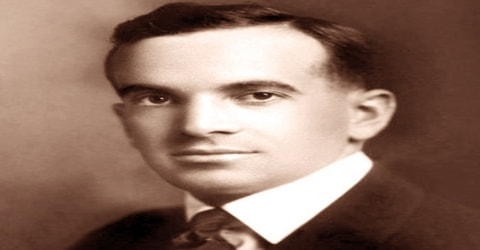
In 1900 Jolson left Washington, D.C., for New York. His first theater job was in a show called Children of the Ghetto. He also sang in a circus before teaming up with his brother to play vaudeville (traveling stage entertainment consisting of various acts). They toured as Jolson/Palmer/Jolson (Palmer was the third member of the team) with an act called The Hebrew and the Cadet, in which Harry Jolson and Palmer did a comedy routine and Al Jolson sang. Jolson was best when he was alone on stage, where he could more easily relate to the audience.
Al Jolson started his career as an usher in 1902 in Walter L. Main’s circus; later, he went on to become a singer there. After that, he joined the ‘Dainty Duchess Burlesquers’ show. However, these shows closed soon. Jolson partnered with his brother Hirsch and they started working as vaudeville performers for the William Morris Agency.
In May 1903, the head producer of the burlesque show Dainty Duchess Burlesquers agreed to give Jolson a part in one show. He performed “Be My Baby Bumble Bee”, and the producer agreed to keep him, but the show closed by the end of the year. He avoided financial troubles by forming a vaudeville partnership with his brother Hirsch, a vaudeville performer known as Harry Yoelson. The brothers worked for the William Morris Agency. Jolson and Harry formed a team with Joe Palmer. During their time with Palmer, they were able to gain bookings in a nationwide tour. However, live performances were falling in popularity as nickelodeons attracted audiences; by 1908, Nickelodeon theaters were dominant throughout New York City. While performing in a Brooklyn theater in 1904, Jolson began performing in blackface, which boosted his career. He began wearing blackface in all of his shows.
Jolson and Hirsch teamed with Joe Palmer and toured the nation. The lack of popularity for the shows made them start performing in blackface, a form of theatrical makeup used by non-black actors to perform as a black person. This guise became a regular for them as it was an instant hit. Jolson started performing on his own in 1906 at the Globe and Wigwam Theatre in San Francisco, where he gained more success as a singer.
Jolson performed with his brother and others in vaudeville before joining Lew Dockstader’s minstrel troupe in 1909. He became a popular New York entertainer and singer, being featured in the musicals La Belle Paree (1911), Honeymoon Express (1913), Bombo (1921), and Big Boy (1925). In Sinbad (1918) he transformed an unsuccessful George Gershwin song, “Swanee,” into his trademark number. And in Bombo, he introduced “My Mammy.” The same show included three Jolson favorites: “Toot, Toot, Tootsie,” “California, Here I Come,” and “April Showers.” Some of his biggest successes were achieved at the New York Winter Garden.
Jolson appeared in the musical comedy, ‘La Belle Paree,’ at the Winter Garden in 1911. This was a tremendous success. The show folded after 104 performances and Jolson’s popularity was at its peak. Jolson later performed in the musical, ‘Vera Violetta’, which was a success too. His tenure at the Winter Garden included several successful runs. He starred as a lead character in ‘Robinson Crusoe Jr.’ in 1916. Next, he acted in ‘Sinbad’. With these two musicals to his credit, he became the biggest star on Broadway.
In 1918, his acting career was pushed further after he starred in the hit musical Sinbad. It became the most successful Broadway musical of 1918 and 1919. “Swanee” was added to the show and became composer George Gershwin’s first hit recording. Jolson added “My Mammy”. The same show included three Jolson favorites: “Toot, Toot, Tootsie,” “California, Here I Come,” and “April Showers.” Some of his biggest successes were achieved at the New York Winter Garden.
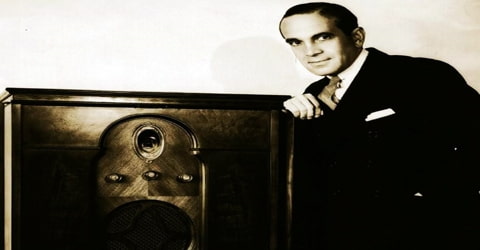
His play ‘Bombo’ (1921) enshrined his name in history, and a theatre near Central Park was named after him. His success only soared after this, and he went to New York to become a part of the Century Theater. Jolson soon started acting in films. His second film, ‘The Jazz Singer’ (1926) by the Warner Bros, made him some sort of a legend as it was for the first time that people saw an actor talk on the screen. Since it was the first feature-length motion picture with synchronized music and speech, the audience was spellbound and cheered Jolson throughout.
In March 1922, Jolson moved the production to the larger Century Theater for a benefit performance to aid injured Jewish veterans of World War I. After taking the show on the road for a season, he returned in May 1923, to perform Bombo at the Winter Garden. The reviewer for The New York Times wrote, “He returned like the circus, bigger and brighter and newer than ever… Last night’s audience was flatteringly unwilling to go home, and when the show proper was over, Jolson reappeared before the curtain and sang more songs, old and new.”
Jolson worked constantly, doing a tour of his one-man show, then a vaudeville tour, and then a Sunday theater series. Finally, he went to Hollywood to make movies. In October 1927 Warner Brothers presented the world’s first talking-picture feature, The Jazz Singer. The film, the story of a rabbi’s son who becomes an actor against his father’s wishes, was a great success. People assumed the movie was based on Jolson’s own life, a myth that he encouraged.
His next film, ‘The Singing Fool,’ released in 1928 and was even more popular than ‘The Jazz Singer’. The movie held a box-office record for 11 years. He continued featuring in films for Warner Bros., including ‘Say it with Songs’, ‘Mammy’, ‘Big Boy’, and ‘Show Girl in Hollywood’. Owing to the general shift in public consumption and taste, he decided to go back to Broadway for the show, ‘Wonder Bar’. This wasn’t successful.
Jolson made several more films, but his personal appeal to an audience never really came through on the screen. His career declined in the 1930s, but he continued to perform on radio and entertained soldiers during World War II (1939–45; a war fought mostly in Europe between the United States, Great Britain, France, and the Soviet Union on one side, and Germany, Italy, and Japan on the other). He also campaigned for several presidents by singing at rallies.
Jolson made his comeback with the film, ‘Hallelujah, I’m a Bum,’ in 1933. Jolson later went on to perform in many movies with the Warner Bros. until his contract ended in 1935. His last movie with them was ‘The Singing Kid’. He later appeared in a Twentieth Century Fox production, ‘Rose of Washington Square’. He also performed regularly on radio and hosted some radio shows well into the 1940s, including ‘Presenting Al Jolson’, ‘Shell Chateau, and ‘Kraft Music Hall’.
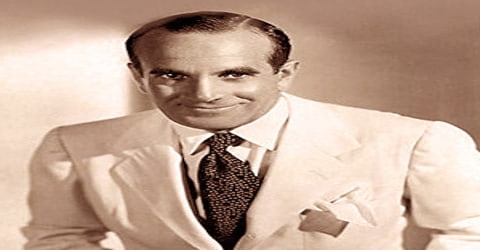
In 1934, Jolson starred in a movie version of his earlier stage play Wonder Bar, co-starring Kay Francis, Dolores del Río, Ricardo Cortez, and Dick Powell. The movie is a “musical Grand Hotel, set in the Parisian nightclub owned by Al Wonder (Jolson). Wonder entertains and banters with his international clientele.” Reviews were generally positive: “Wonder Bar has got about everything. Romance, flash, dash, class, color, songs, star-studded talent and almost every known requisite to assure sturdy attention and attendance… It’s Jolson’s comeback picture in every respect.”; and, “Those who like Jolson should see Wonder Bar for it is mainly Jolson; singing the old reliables; cracking jokes which would have impressed Noah as depressingly ancient, and moving about with characteristic energy.” His last Warner vehicle was The Singing Kid (1936), a parody of Jolson’s stage persona (he plays a character named Al Jackson) in which he mocks his stage histrionics and taste for “mammy” songs—the latter via a number by E. Y. Harburg and Harold Arlen titled “I Love to Singa”, and a comedy sequence with Jolson doggedly trying to sing “Mammy” while The Yacht Club Boys keep telling him such songs are outdated.
Jolson first performed at a GI base in 1942. He later covered many U.S. Naval bases. He traveled to Korea during the Korean War, sponsoring his own trip this time. He performed in around 40 shows over 16 days at the Army Headquarters. These performances renewed his popularity among the public in the late 1940s. His life was portrayed in his biopic, ‘The Jolson Story’ (1946), and became one of the biggest hits. Jolson appeared in a musical sequence and its popularity made Decca Records sign Jolson. The sequel, ‘Jolson Sings Again,’ was released later and remained highly popular. He remained with Decca Records till the end of his life.
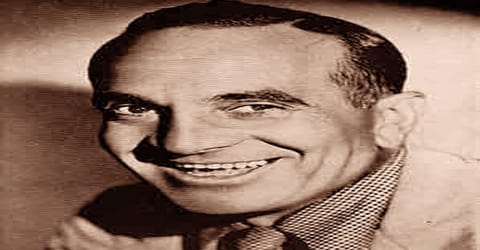
A sequel, Jolson Sings Again (1949), opened at Loew’s State Theatre in New York and received positive reviews: “Mr. Jolson’s name is up in lights again and Broadway is wreathed in smiles”, wrote Thomas Pryor in The New York Times. “That’s as it should be, for Jolson Sings Again is an occasion which warrants some lusty cheering…”. Jolson did a tour of New York film theaters to plug the movie, traveling with a police convoy to make timetables for all showings, often ad-libbing jokes and performing songs for the audience. Extra police were on duty as crowds jammed the streets and sidewalks at each theater Jolson visited. In Chicago, a few weeks later, he sang to 100,000 people at Soldier Field, and later that night appeared at the Oriental Theatre with George Jessel where 10,000 people had to be turned away.
Awards and Honor
Al Jolson has three stars on the Hollywood Walk of Fame contributions to radio, motion pictures, and the recording industry.
In 2000, a Golden Palm Star on the Palm Springs, California, Walk of Stars was dedicated to him. Jolson is also a member of the American Theater Hall of Fame.
Death and Legacy
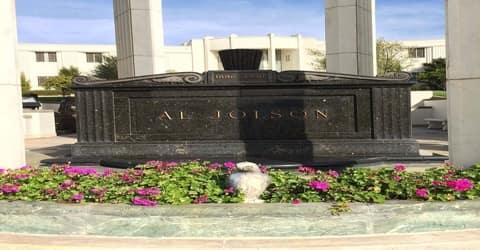
While playing cards in his suite at the St. Francis Hotel at 335 Powell Street in San Francisco, Al Jolson died of a massive heart attack on October 23, 1950. His last words were said to be “Oh… oh, I’m going.” His age was given as 64. His trip to Korea had made him physically weak and he suffered from a collapsed lung as a result. Over 20,000 people showed up at his funeral.
Al Jolson was interred in the Hillside Memorial Park Cemetery in Culver City, California. Jolson’s widow purchased a plot at Hillside and commissioned his mausoleum to be designed by well-known black architect Paul Williams. The six-pillar marble structure is topped by a dome, next to a three-quarter-size bronze statue of Jolson, eternally resting on one knee, arms outstretched, apparently ready to break into another verse of “Mammy”. The inside of the dome features a huge mosaic of Moses holding the tablets containing the Ten Commandments, and identifies Jolson as “The Sweet Singer of Israel” and “The Man Raised Up High”.
Al Jolson’s most famous performance is his role in the 1926 film, ‘The Jazz Singer’. The story closely mirrored his own life. It was immensely popular because it incorporated lip-synchronous speech on the screen with dramatic Vitaphone sequences. Jolson became a huge star after the film.
On the day he died, Broadway dimmed its lights in Jolson’s honor, and radio stations all over the world were paying tributes. Soon after his death, the BBC presented a special program entitled Jolson Sings On. His death unleashed tributes from all over the world, including a number of eulogies from friends, including George Jessel, Walter Winchell, and Eddie Cantor. He contributed millions to Jewish and other charities in his will.
His legacy is evident from the awards that were conferred to him posthumously. He has three stars on the Hollywood Walk of Fame, a Golden Palm Star on the Palm Springs, California, and he was also made a member of the American Theater Hall of Fame. His popularity continues even today. The United States Postal Service honored his services by issuing a postage stamp in 1994. His music and performances are fondly remembered by the International Al Jolson Society.
The U.S. Postal Service honored him by issuing a 29-cent stamp that was unveiled by Erle Jolson Krasna, Jolson’s fourth wife, at a ceremony in Lincoln Center on September 1, 1994. This stamp was one of a series honoring popular American singers, which included Bing Crosby, Nat King Cole, Ethel Merman, and Ethel Waters. In 2006, Jolson had a street in New York named after him with the help of the Al Jolson Society.
Information Source:


